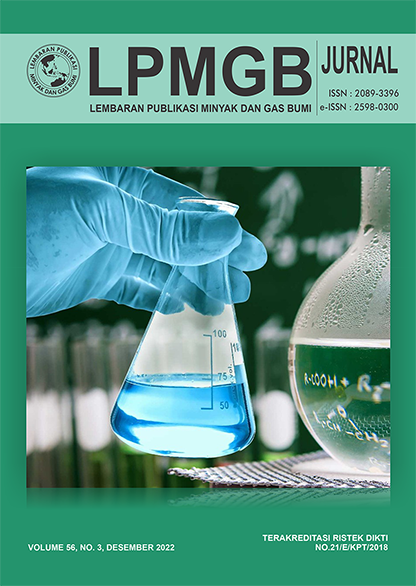Rock Typing Pada Reservoar Gas Upper Eastern View Coal-Measures (EVCM), Cekungan Bass, Australia
DOI:
https://doi.org/10.29017/LPMGB.56.3.1100Kata Kunci:
Rock Typing, Hydraulic Flow Unit, Global Hydraulic - Element, Winland R35, Pore Geometry StructureAbstrak
Kesulitan terkadang muncul ketka menentukan permeabilitas, terutama pada interval yang tidak memiliki data batuan inti (core). Pada penelitian ini, digunakan teknik sedimentary rock type (SRT) dan petrophysical rock type (PRT) dengan tujuan untuk mengurai permasalahan tersebut. SRT terdapat 4 rock type, yaitu thoroughly bioturbated sandstone and mudstone, fl aser bedded sandstone, laminated sandstone and mudstone, dan thoroughly bioturbated mudstone. Teknik PRT dilakukan dengan mengkomparasikan metode Hydraulic Flow Unit, Global Hydraulic Element, Winland R35, dan Pore Geometry Structure untuk mendapatkan metode yang paling cocok. Hasilnya, metode GHE yang menghasilkan nilai permeabilitas prediksi paling mendekati nilai permabilitas dari data core (koefi sien korelasi 0,9139). Aplikasi metode GHE pada interval yang tidak memiliki data core dilakukan dengan menggunakan data wireline log menghasilkan 4 RT (RT 1, RT 2, RT 3, dan RT 4). Setiap rock type tersebut digunakan rumusan poro-perm transform-nya untuk mementukan nilai permeabilitas. Dipadukan dengan data DST, dapat diambil nilai cut-off , yaitu porositas 0,183, permeabilitas 0,55 mD, volume shale 0,6, dan saturasi air 0,99. Dengan nilai cut-off tersebut menghasilkan satu zona potensial pada kedalaman 2216 mRT - 2234 mRT. Dengan demikian maka manfaat yang didapatkan dari penelitian ini antara lain: mengetahui metode PRT yang cocok diaplikasikan di reservoir ini, jumlah rock type beserta karakteristiknya, serta zona yang potensial.
Referensi
Abdullah, M. dan Garrouch, A., 2019, A
New Approach for Rock Typing Using Dimensional
Analysis: A Case Study of Carbonate
Reservoir, SPE Kuwait Oil & Gas
Show and Conference: Mishref, Society of
Petroleum Engineers.
Akbar, M. N. A., 2019, New Approaches of Porosity-
Permeability Estimations and Quality
Factor Characterization based on Sonic Velocity,
Critical Porosity, and Rock Typing,
pada SPE Annual Technical Conference and
Exhibition: Calgary, Society of Petroleum
Engineers
Armaya, C. I., & Setyowiyoto, J., 2019, Rock
Typing Reservoar Batuan Karbonat Pada
Interval Mid Main Carbonate Formasi Cibulakan
Atas Lapangan Ca, Cekungan Jawa
Barat Utara [unpublished B.E thesis]: Yogyakarta,
Universitas Gadjah Mada, Abstrak.
Beach Energy, 2018, Bassgas Environment
Plan Revision: https://beachenergy.com.
au/wp- content/uploads/2018/10/Bass-
GassFactSheet.pdf
(diakses Juli 2020).
Brooks, D. M., Pidgeon, B. A., Hall, A. D.,
Taylor, R. J., & Parvar, J. L., 2006, Appraising
The Yolla Field In The Bass Basin—
How Eff ective Data Collection, Analysis
And Integration Increased Estimated
Hydrocarbon Volumes In Place, The APPEA
Journal 46(1), pp 15-34.
de Leon, J. M., Gunter, G., & Viro, E., 2015,
Challenges of Determining Petrophysical
Reservoir Characterizations in Complex
Low Porosity Fractured Carbonates– Integrating
Pore Geometry, Deterministic Petrophysical
Rock Types and Saturation Height
Models Yields Positive Results–Pemex
Case Study Off shore Mexico, pada SPWLA
th Annual Logging Symposium: Long
Beach, Society of Petrophysicists and Well-
Log Analysts.
Farshi, M., Moussavi-Harami, R., Mahboubi,
A., Khanehbad, M., & Golafshani, T.,
, Reservoir Rock Typing Using Integrating
Geological and Petrophysical Properties
for The Asmari Formation in The
Gachsaran Oil Field, Zagros Basin, Journal
of Petroleum Science and Engineering, 176,
-171.
Haikel, S., Rosid, M. S., & Haidar, M. W.,
, Study Comparative Rock Typing
Methods to Classify Rock Type Carbonate
Reservoir Field “S†East Java, Journal of
Physics: Conference Series (Vol. 1120, No.
, p. 012047), pp 100 – 110.
Kadkhodaie-Ilkhchi, A., & Kadkhodaie-
Ilkhchi, R., 2018, A Review of Reservoir
Rock Typing Methods in Carbonate
Reservoirs: Relation Between Geological,
Seismic, and Reservoir Rock Types, Iranian
Journal of Oil & Gas Science and Technology
(4), pp 13-35.
Michel, R. & Bruno, L., 2014, Rock-typing in
Carbonates: A Critical Review of Clustering
Methods. In Abu Dhabi International Petroleum
Exhibition and Conference. OnePetro.
Mirzaei-Paiaman, A., Sabbagh, F., Ostadhassan,
M., Shafi ei, A., Rezaee, R., Saboorian-
Jooybari, H., & Chen, Z. 2019,
A Further Verifi cation of FZI* and PSRTI:
Newly Developed Petrophysical Rock Typing
Indices, Journal of Petroleum Science
and Engineering, 175, 693-705.
Palabiran, M., Sesilia, N., & Akbar, M. N. A.,
, An Analysis of Rock Typing Methods
in Carbonate Rocks for Better Carbonate
Reservoir Characterization: A Case Study
of Minahaki Carbonate Formation, Banggai
Sula Basin, Central Sulawesi, 41st Scientifi c
Annual Meeting of Indonesian Association
of Geophysicists: Lampung, Himpunan Ahli
Geofi sika Indonesia.
Permadi, Pudji & Akbar, Muhammad Nur
Ali., 2014, Reservoir Characterization: Case
Study of a Marginal Field (Karakterisasi
Reservoir: Studi Kasus Lapangan Marginal).
Porras, J. C., Barbato, R., & Khazen, L.,
, Reservoir Flow Units: A Comparison
Between Three Diff erent Models in
The Santa Barbara and Pirital Fields, North
Monagas Area, Eastern Venezuela Basin,
Latin American and Caribbean Petroleum
Engineering Conference: Caracas, Society
of Petroleum Engineers.
Soleymanzadeh, A., Parvin, S., & Kord, S.,
, Eff ect of Overburden Pressure on Determination
of Reservoir Rock Types Using
RQI/FZI, FZI* and Winland Methods in
Carbonate Rocks, Petroleum Science, 16(6),
-1416.
Surjono, S. S., & Arifi anto, I., 2016, Petrophysics
Analysis for Reservoir Characterization
of Upper Plover Formation in The
Field ‘A’, Bonaparte Basin, Off shore Timor,
Maluku, Indonesia. J. Appl. Geol., 1, 43-52.
Wibowo, A. S., & Permadi, P., 2013, A Type
Curve for Carbonates Rock Typing, pada
IPTC 2013: Beijing, International Petroleum
Technology Conference, pp 350.











